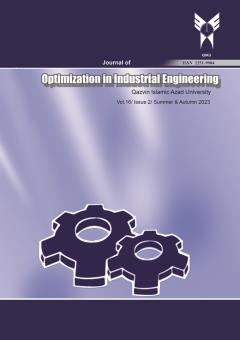-
-
List of Articles
-
Open Access Article
1 - Diabetes detection via machine learning using four implemented spanning tree algorithms
Yas Ghiasi Mehdi Seifbarghy Davar Pishva -
Open Access Article
2 - Organizational Competitive Advantage Analysis using SWOT Matrix and Hybrid Approach of Fuzzy-DEMATEL, ANP, and DEA
Ali Taherinezhad Alireza Alinezhad Saber Gholami Mahsa Abdolvand -
Open Access Article
3 - A Robust Optimization Approach for the Hub Arc Location Problem
Marjan Gharavipour Mohsen Sheikh Sajadieh Matineh Ziari -
Open Access Article
4 - Providing a multi-objective sustainable distribution network of agricultural items considering uncertainty and time window using meta-heuristic algorithms
Abbas Toloie Ashlaghi Amir Daneshvar Adel Pourghader Chobar Fariba Salahi -
Open Access Article
5 - An inventory lot Sizing model of deteriorating items with time and price dependent demand, by considering the time value of money
Rashin Babaei Davood mohammaditabar -
Open Access Article
6 - A Dynamics Approach for Maturity Assessment of Hospital Supply Chain Management
Marla Setiawati Togar Mangihut Simatupang Liane Okdinawati -
Open Access Article
7 - Implementation of Internet of Things in the Manufacturing Value Chain: A Comprehensive Study in Industry of Piping
Rahimah Kassim Hasnah Mustapa Azizah Rahmat Hamad Raza -
Open Access Article
8 - Conceptual Framework for Implementing Bottom-Up Kaizen in the Malaysian Automotive Sector
S.K. Kamal ZA Rahim I. Norzura H Nakanishi Hamad Raza -
Open Access Article
9 - Appraisal of industrial plans with Expected Monetary Value approach using FAHP in the ceramic and tile industry
Masoud Merati -
Open Access Article
10 - A Community-Based Qualitative Vulnerability Assessment Tools for Rivers in Developing Participatory Response to Land-Use Changes
Muhammad Saeed Aazani Mujahidb Moritz Müller -
Open Access Article
11 - Optimizing Outsourcing Decisions in the Service Sectors and Businesses: A Comprehensive DSS Model for Effective Ranking and Selection
Moezodin Mazaheri Tirani Mahdi Karbasian hadi shirouyehzad -
Open Access Article
12 - The survey of lean implementation maturity level of hospitals in Thailand: Does the hospital type matter?
Kwanchanok Areewong Vichayanan Rattanawiboonsom Robert Van Der Meer -
Open Access Article
13 - Navigation of mobile robot motion
Hameedah Sahib Hasan -
Open Access Article
14 - Assessing the influence factors of audit fatigue and its impact on audit quality
Siti Zaharah Yacob Sallaudin Hassan Hamad Raza -
Open Access Article
15 - The Influence of Logistics Performance on Company Performance in the Small and Medium Industry
Qurtubi Qurtubi M Suyanto Anas Hidayat Elisa Kusrini -
Open Access Article
16 - Financial Health Analysis on PT Asuransi LMIGNKG Based on Premium Reserve Calculation
Fia Fridayanti Adam -
Open Access Article
17 - Agricultural Infrastructure Funding Assessment: Research Opportunities and Trends
M. Rezki Mulyono Yusuf Latief Ayomi Dita Rarasati Hamad Raza
-
The rights to this website are owned by the Raimag Press Management System.
Copyright © 2021-2026







